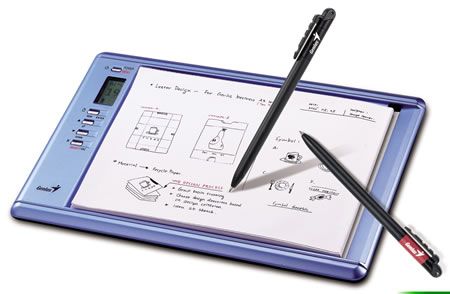The concept is nothing new, it is that of the digital pen and paper: take notes on the paper pad and everything you write or draw is also immediately copied onto the built-in 32MB of Flash memory as a digital image that can be transferred to your PC later via a USB cable.
What is different however is that the G-Note 5000 is one of the smallest, lightest and best looking of these kind of devices we have seen though. Small at just 281 x 180 x12mm, but the active working area is smaller still being 210 x 150mm, which is an A5 sheet of paper.
However, unlike some digital note taking solutions, this one doesn’t demand special paper. Any A5 pad will do, as long as it doesn’t exceed a total thickness of 15mm (about 150 pages), which is nice.
The G-Note is also light, just 350g plus the four AAA batteries which don’t exactly add much to the lugability factor. The batteries go a surprisingly long way, Genius claim as far as 80 hours of continuous use for the notepad and 1000 hours for the 1.4V button cell battery powered pens.
Not that we can see ourselves putting that to the test, as the included software is somewhat clunky and the resulting JPG/BMP image files not of the highest quality. The 200 points per second report rate and 2000LPI resolution translate into wobbly handwriting in our experience.
The proprietary software, Digital Organizer, doesn’t help matters either. It allows you to view, organise, annotate and edit the digital pages which can then be copied or attached to Excel, Outlook Express, PowerPoint or Word files for sharing.
But it is clunky, and does not allow the same smooth integration with Office applications that you would get using a TabletPC and Microsoft OneNote for example. But then again, the G-Note 5000 costs less than a copy of OneNote let alone a TabletPC. And the G-Note acts as a (very) rudimentary graphics tablet when attached to your PC for good measure.
Transfer of your output is via USB, but unfortunately it is only USB1 so don’t expect this to be a particularly speedy process. The 32MB of built-in Flash memory isn’t overly generous either, and is good for around 100 pages only.
The rotation function, letting you write in either plane, functions well though and the addition of a basic, and very small, LCD menu screen is welcome.
But then there are those pens, without which you are left with a pretty pointless plastic paper holder.
They really are very poor quality indeed. Not only do they feel as flimsy as the ballpoint pen you get with some charity junk mail.
These really are not good to hold, and you can’t simply use your own favourite pen instead because these are battery powered beasts utilising an electronic magnetic technology in order to achieve the digital as well as ink input.
You do get two though, and a set of spare ink cartridges, one read and one black. What you don’t get is any easy way of carrying both, as only one pen clip storage device is built into the tablet itself. The fact that there are no pens caps means that you probably wouldn’t want to leave one of these in your pocket for fear of ink leakage.
Our quick take
We can’t think of a single scenario where this is any better than a PDA with handwriting recognition capability, or a sub-notebook/TabletPC running Microsoft OneNote or even pen and paper. The G-Note is best described as a solution looking for a problem.

G-Note 5000 digital note taker - 3.0 / 5
| FOR | AGAINST |
|---|---|
|
|
To recap
An odd hybrid of digital notepad and graphics tablet that still requires both pen and paper
